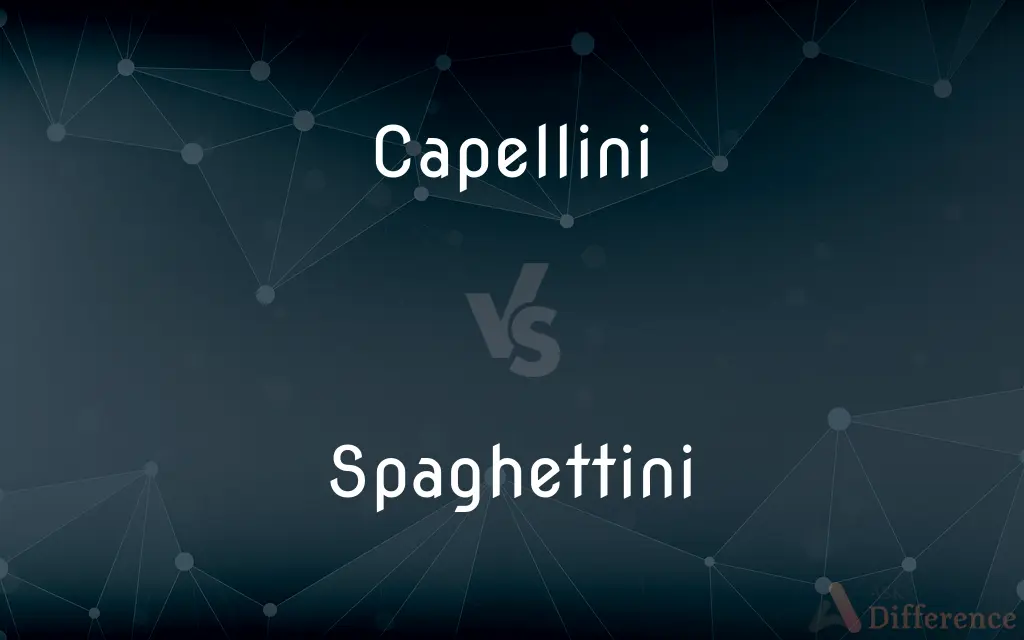Capellini vs. Spaghettini — What's the Difference?
Edited by Tayyaba Rehman — By Urooj Arif — Updated on April 27, 2024
Capellini and spaghettini are both thin varieties of pasta, with capellini being the thinner of the two, often referred to as "angel hair," while spaghettini is slightly thicker but still finer than traditional spaghetti.

Difference Between Capellini and Spaghettini
Table of Contents
ADVERTISEMENT
Key Differences
Capellini, often called "angel hair pasta," is characterized by its extremely thin strands, making it one of the finest forms of spaghetti. Whereas spaghettini, although also a thin pasta, is slightly thicker than capellini, and offers a bit more texture when cooked.
Due to its very fine texture, capellini cooks very quickly, typically in less than two minutes, making it perfect for light, delicate sauces. On the other hand, spaghettini takes slightly longer to cook, pairing well with slightly heartier sauces that are still relatively light.
The delicate nature of capellini makes it an ideal choice for simpler sauces, such as those based on olive oil or a light tomato sauce. In contrast, spaghettini can handle more robust flavors like garlic and herbs, without overpowering the dish.
In culinary applications, capellini is often served in broths or with seafood dishes where its fine strands complement the subtlety of the flavors. Spaghettini, while still fine, is versatile enough to be used in a broader range of dishes, including those with creamier sauces.
When choosing between the two, consider the sauce and the desired balance of pasta to sauce ratio. Capellini's thin strands are easily overwhelmed by too much sauce, whereas spaghettini can hold up slightly better with a bit more sauce.
ADVERTISEMENT
Comparison Chart
Thickness
Very thin, finer than spaghettini.
Thinner than spaghetti but thicker than capellini.
Cooking Time
Cooks in under 2 minutes.
Takes slightly longer than capellini.
Ideal Sauces
Light, delicate sauces like olive oil or light tomato.
Light to medium sauces, such as garlic oil or light creamy sauces.
Culinary Uses
Best in broths or with seafood.
Versatile, suitable for a range of lighter dishes.
Texture When Cooked
Very delicate, soft.
Slightly more texture, holds up better under slightly heavier sauces.
Compare with Definitions
Capellini
Extremely thin, delicate pasta often termed as "angel hair."
Capellini tossed with garlic, olive oil, and parsley showcases its delicate nature.
Spaghettini
Suitable for slightly heartier sauces than capellini, providing a good sauce-to-pasta ratio.
Tossed spaghettini with a garlic and cherry tomato sauce is a robust yet simple dish.
Capellini
Best paired with light sauces or broths to complement its fine texture.
Capellini in a light basil and tomato broth is a refreshing meal.
Spaghettini
Thinner than traditional spaghetti but thicker than capellini, known for a slightly firmer texture.
Spaghettini with a light lemon cream sauce offers a balanced texture.
Capellini
Often used in dishes requiring a quick cook time.
Capellini with shrimp cooks in just minutes for a quick dinner.
Spaghettini
Versatile in its use, accommodating a variety of cooking styles.
Spaghettini served with a basil pesto and pine nuts highlights its adaptability.
Capellini
Ideal for highlighting subtle flavors in seafood dishes.
Capellini with clams and a splash of white wine emphasizes delicate seafood flavors.
Spaghettini
Holds up well with quick sauté dishes, maintaining a good texture.
Stir-fried spaghettini with vegetables and soy sauce for an Asian-inspired meal.
Capellini
Cooks faster than most pastas, needing careful attention.
Quickly boiled capellini pairs well with a drizzle of truffle oil for an elegant dish.
Spaghettini
Provides a delicate yet noticeable presence in dishes, balancing flavor and texture.
Spaghettini with a zesty arrabbiata sauce strikes a perfect balance.
Capellini
Capellini (Italian pronunciation: [kapelˈliːni], literally "little hairs") is a very thin variety of Italian pasta, with a diameter between 0.85 and 0.92 millimetres (0.033 and 0.036 in). Like spaghetti, it is rod-shaped, in the form of long strands.
Spaghettini
Pasta in long fine strands.
Capellini
See angel hair.
Spaghettini
A form of thin spaghetti
Capellini
Synonym of angel hair
Spaghettini
Thin spaghetti
Common Curiosities
How does spaghettini compare to regular spaghetti?
Spaghettini is thinner than regular spaghetti, offering a lighter texture and quicker cooking time.
What is capellini pasta?
Capellini, or angel hair pasta, is a very thin variety of spaghetti known for its delicate texture.
How should capellini be served to best enjoy its texture?
Capellini is best served immediately after cooking with light sauces to prevent it from clumping or becoming soggy. Tossing it gently with sauce right after draining helps coat the strands evenly.
Are there any specific health differences between capellini and spaghettini?
Nutritionally, capellini and spaghettini are quite similar, both primarily made from durum wheat semolina. The main consideration would be portion size and sauce choice in terms of health.
What are some traditional Italian dishes that use spaghettini?
Traditional Italian dishes that use spaghettini often include seafood recipes, such as spaghettini with garlic and oil (aglio e olio) or with anchovies and breadcrumbs.
Can I substitute spaghettini for capellini in recipes?
Yes, spaghettini can substitute for capellini, especially in recipes where a slightly firmer pasta texture is desirable. However, adjust cooking times accordingly to avoid undercooking or overcooking.
What are the best cooking tips for capellini?
Capellini should be cooked in a large pot of boiling, salted water for about 1 to 2 minutes. It's crucial to monitor it closely as it can quickly overcook and become mushy.
What is the origin of capellini pasta?
Capellini has its origins in Italy, particularly popular in the northern regions where it is traditionally served with light seafood sauces or simple tomato and basil sauces.
Why might someone choose capellini over spaghettini?
Someone might choose capellini over spaghettini for its delicate texture that pairs well with very light sauces, making it ideal for dishes that require subtlety and quick preparation.
Can spaghettini be used in baked pasta dishes?
Yes, spaghettini can be used in baked pasta dishes. Its slightly thicker structure holds up well under the additional cooking time in the oven, especially in dishes like baked tomato and cheese pasta.
Is capellini suitable for cold pasta salads?
Capellini is generally not recommended for cold pasta salads as it tends to clump together when cooled. Pasta with a bit more structure like spaghettini would be a better choice for salads.
What are the main considerations when shopping for high-quality capellini or spaghettini?
Look for pasta made with 100% durum wheat semolina for the best quality, which offers a good texture and flavor. Also, consider brands that are imported from Italy for authenticity.
What makes spaghettini different from capellini in terms of flavor?
While both pastas are subtle in flavor, allowing them to pair well with various sauces, spaghettini's slightly thicker diameter provides a more pronounced pasta texture and mouthfeel, which might influence the flavor experience slightly.
How does the preparation of sauces differ for spaghettini vs. capellini?
Sauces for capellini should be particularly light and liquidy to coat the thin strands without overwhelming them, whereas spaghettini can handle slightly thicker and creamier sauces due to its greater thickness.
How does the thickness of the pasta affect the sauce pairing?
Thinner pastas like capellini are better with light, oil-based sauces as they cling to the fine strands more easily, while thicker pastas like spaghettini are great for slightly heartier sauces which balance out the texture.
Is there a difference in the way capellini and spaghettini should be stored?
Both capellini and spaghettini should be stored in a cool, dry place. Once cooked, any leftovers should be refrigerated and consumed within a couple of days for the best quality.
How can I prevent capellini from sticking together?
To prevent capellini from sticking, stir it frequently during the very short cooking time, and consider adding a little oil to the cooking water. It's also helpful to use enough water to give the pasta plenty of room to move.
Share Your Discovery

Previous Comparison
Chartered vs. Certified
Next Comparison
Recoding vs. DecodingAuthor Spotlight
Written by
Urooj ArifUrooj is a skilled content writer at Ask Difference, known for her exceptional ability to simplify complex topics into engaging and informative content. With a passion for research and a flair for clear, concise writing, she consistently delivers articles that resonate with our diverse audience.
Edited by
Tayyaba RehmanTayyaba Rehman is a distinguished writer, currently serving as a primary contributor to askdifference.com. As a researcher in semantics and etymology, Tayyaba's passion for the complexity of languages and their distinctions has found a perfect home on the platform. Tayyaba delves into the intricacies of language, distinguishing between commonly confused words and phrases, thereby providing clarity for readers worldwide.
















































